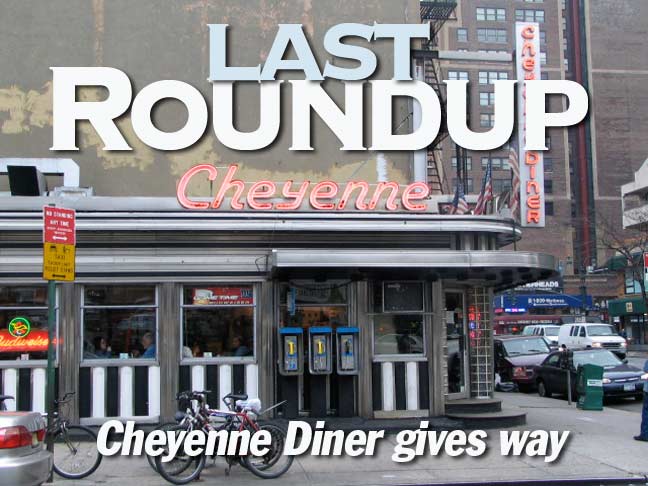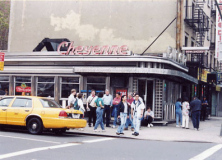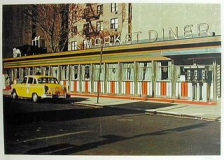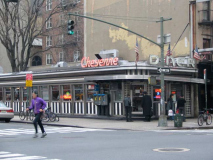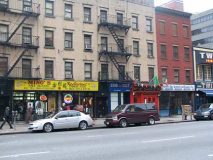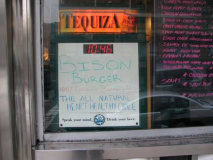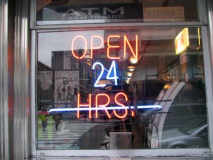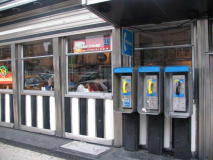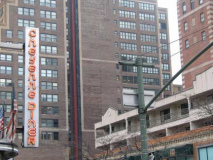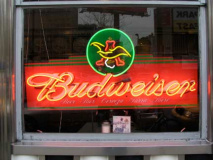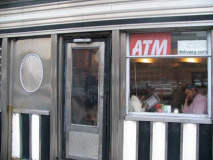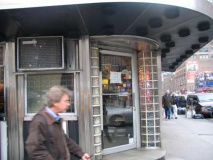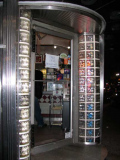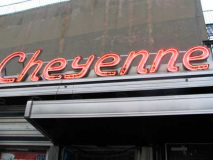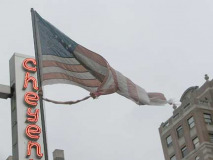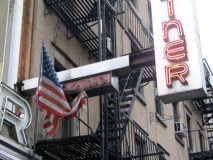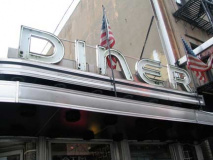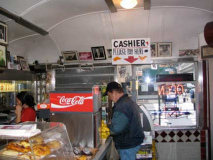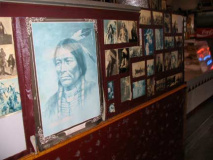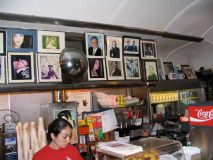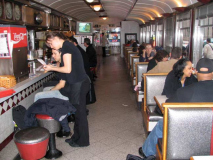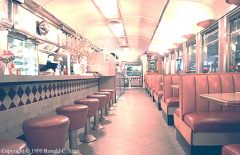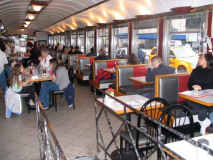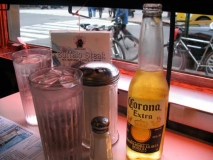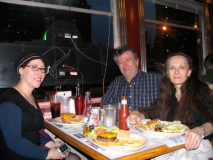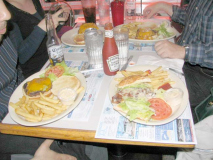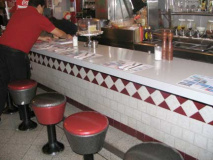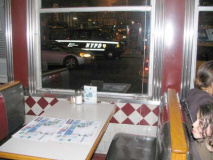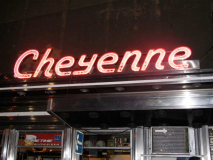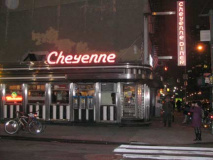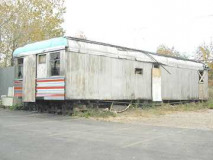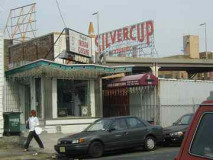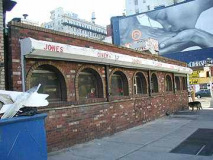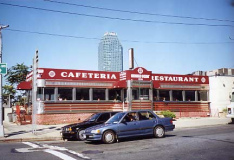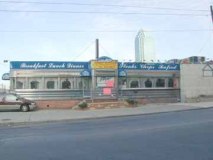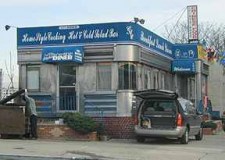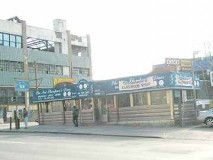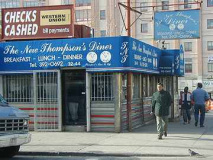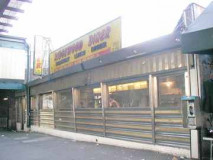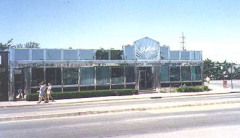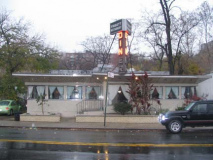I’m not sure when I first visited the Cheyenne Diner — it must have been before ForgottenTour 12 in Hell’s Kitchen gathered there (left) in May 2003; it must have been while I worked at the World’s Biggest Store between April 2000 and October 2004. The Cheyenne is closing, at least in its present location at 9th Avenue and West 33 Street, on the evening of April 6, 2008.
The Cheyenne Diner began as the Market Diner in this location sometime in the early 1940s. The diner manufacturer was Paramount Modular Concepts of Oakland, NJ, in business since 1932 and one of only a handful of diner manufacturers (Diner-Mite of Atlanta, GA, De Raffele of New Rochelle, NY, and Kullman of Lebanon, NJ are among the others) still in operation today; Kullman doesn’t seem to be making them anymore, however. photo: John Baeder, via Jeremiah’s Vanishing NY
According to Diner City, Paramount was the first manufacturer to introduce an all-stainless-steel exterior. Paramount diners featured a distinctive curved roofline, and rounded glass block corners. Many of its earlier diners, such as ?White Manna Hamburgers in Hackensack, New Jersey, are adorned with a “wainscoating” of beveled vertical porcelin panels. In the mid-40’s, Paramount introduced the all-stainless exterior. ?Rosie’s Diner now in Rockford, Michigan is a glistening example.
With the demise of the Deerhead Diner on Astoria Blvd. in Jackson Heights in the early 2000s, and the closing of the Cheyenne, Paramount’s two most prominent local representative diners are now the White Mana on Tonnele Avenue in Jersey City, built in 1939 for the Flushing Meadows World’s Fair and moved to JC in 1946, and its cousin, the White Manna, on River Street in Hackensack, opened the same year. The JC White Mana originally had the extra “N” but an error by a sign repairer dropped it in the mid-1980s. Your webmaster plans to visit both.
A New Jersey Pilgrimage [A Hamburger Today]
Today, though, we’re here to see the Cheyenne Diner off. The diner was re-named about 20 years ago for the Cheyenne Native American nation of the northern Great Plains, Montana and the Dakotas (originally from Minnesota).
The Cheyenne were generally friendly toward white settlers, until the discovery of gold in Colorado (1858) brought a swarm of gold seekers into their lands. By a treaty signed in 1861 the Cheyenne agreed to live on a reservation in SE Coorado, but the U.S. government did not fulfill its obligations, and the Native Americans were reduced to near starvation. Cheyenne raids resulted in punitive expeditions by the U.S. army. The indiscriminate massacre (1864) of warriors, women, and children at Sand Creek, Colo., was an unprovoked assault on a friendly group. The incident aroused the Native Americans to fury, and a bitter war followed. Gen. George Custer destroyed (1868) Black Kettle’s camp on the Washita River, and fighting between the whites and the Southern Cheyenne ended, except for an outbreak in 1874-75. The Northern Cheyenne joined with the Sioux in massacring Custer and his 7th Cavalry at the Battle of the Little Bighorn in 1876. They finally surrendered in 1877 and were moved south and confined with the Southern Cheyenne in what is now Oklahoma. Plagued by disease and malnutrition, they made two desperate attempts to escape and return to the north. A separate reservation was eventually established for them in Montana. [Native Americans]
The west side of 9th Avenue between West 33rd and 34th is pretty much the same as it has been since the 1940s, but in the go-go Midtown real estate picture, in which astronomical prices are now the rule, change is the name of the game and no block is safe anymore. (Stop your webmaster before he clichés again.)
The Cheyenne, open 24 hours daily, was across the street from the massive James Farley Post Office and its 24-hour shifts. Mail processing has largely moved down the street to the Morgan Processing and Delivery Center on 30th Street, while approximately 250,000 square feet of the 1.5 million square-foot building is still used for post office operations, including the famed 8th Avenue windows. The remainder of the building was slated to be converted to a new Penn Station railroad shed, but this plan has largely been up in the air due to developmental hubris, political machinations, and economical ups and downs. (Your webmaster has always maintained that it would never happen.)
The 24-hour schedule remained significant, despite the wind-down of the P.O., since I’ve rarely been here and not seen a line of taxicabs and at least a couple of NYPD patrol cars parked nearby.
Note the poster for the 2008 B52’s offering, Funplex. It wouldn’t be a stretch of the imagination to envision Fred Schneider, Kate Pierson and company occupying a Cheyenne booth. Your webmaster never did sample the Cheyenne bisonburger, and time will tell if they were heart-healthy.
A bank of public phones on the 33rd Street side. (I’ve yet to figure out the significance of the yellow handsets.) Will public phones follow the railroad-car style diner into oblivion in New York?
The classic Cheyenne vertical neon indicator contrasts with the faded ads of long-ago clothing manufacturers and wholesalers on office buildings along West 34th near 9th Avenue. RIGHT: Anheuser-Busch Budweiser neon in one of the windows. Note the words for “beer” in 5 languages at the bottom.
Preservationist Michael Perlman: The Cheyenne is the last streamlined railway car-inspired diner in Mid-Manhattan. It was pre-assembled by Paramount in 1940 and retains a majority of its original/distinctive elements. The facade features vertical and horizontal stainless steel securing bowed colorful enamel panels, wrap-around windows, a curved entryway with glass block, and a reverse channel illuminated neon sign. It was recently granted first prize on ?NYC-Architecture.com’s Top 10 New York Diners/Restaurants. (outpointing the Russian Tea Room and Tavern on the Green!) [via Jeremiah’s Vanishing NYC]
Front and back. Note the glass blocks at the front door…at night they reflect the headlights and taillights of passing traffic (left).
I don’t think glass blocks are used enough. I see them most often on “old man” bars; the 1980s renovation of the stations of the Staten Island Railway also made extensive use of them.
Ragged Glory. We’ll see the Cheyenne sign lit up at night further down the page, but I wanted to show the trio of tattered flags flapping in the breeze. I’ve seen older pictures in which the Union Jack was seen here but I don’t know the occasion. Time to head on in for a last meal.
As far as framed celebrity pictures go, I haven’t been able to peruse them in detail. I recognize the late Fred Berry (1951-2003) from “What’s Happening!!”, the guy who shows up on pledge breaks on WNET, and Curtis Sliwa and Ron Kuby of the late, lamented WABC morning radio show. Anyone recognize anyone else?
Here we see the classic “railroad car” look as mentioned previously. Booths are arranged along the windows as they are in railroad passenger cars. Also, note the curved roofline.
The 2008 look was after a renovation, since the stools and seats used to be tomato-red vinyl.
Photo by Ron Saari, who has photographed hundreds of diners.
Your webmaster has been in the Cheyenne dozens of times, before ForgottenTours and after (when we don’t wind up at Millard Fillmore’s of Flushing, not a diner per se but a dispenser of comfort food, which makes up about 99% of my diet). I have eaten here with friends who have wound up as enemies; I ate with Gary Shapiro of the New York Sun, whose hint of a Forgotten NY article in the Sun didn’t materialize. My favorite meal was the Mohegan burger, a creation consisting of beef, bun, bacon, cheese, BBQ sauce and fried onions.
Chilled with a Corona before the other guests showed up. Note the cabs on 33rd Street in the above two pictures. The Cheyenne was air-cooled and the windows were painted shut; I’m sure they opened in 1940 when the Market Diner opened.
Forgotten Fans Laura G – a prolific diner photographer, and Mary O. with your webmaster. I am normally reluctant to use a photo of myself in FNY; I do not want to frighten any of the little children that see the site, but in this situation, I had little choice. photo: Dave Martinez
Would you believe they got my order wrong for my last meal … I ordered the Mohegan but instead, I got a burger with cheese and Canadian bacon. I was not about to make a fuss with people about to lose their jobs, and while I prefer traditional bacon I don’t mind Canadian. Down the hatch it went. The Cheyenne offered egg creams, and I had never had one, but the one they served me was like regular chocolate milk with a bit of fizz. What’s the fuss all about? Note Mary’s hamburger method: slice it in half first. I have never seen this technique before but I may try it: it looks effective in avoiding a mess.
Eventually it was time to say goodbye to the Cheyenne but not before admiring the decor one last time. Note the maroon and grey scheme, the stools alternating the colors, and the NYPD van.
Why is the Cheyenne closing? Each time I’ve been there it’s been jammed full. George Papas owns the property on which the Cheyenne is located, as well as the Skylight Diner around the corner on West 34th, and wants to build a nine-story apartment complex on the narrow site. It would likely feature a restaurant on the bottom two floors. The diner’s owner, Spiros Kasimis, said in a NY Daily News interview: “We broke our butts here, but the day of one-story structures in ?Manhattan is over.” Sad but true: packed or not, the diner wasn’t maximizing the possible revenue for this site and economic realities of the current Manhattan scene have doomed it … along with other recent Manhattan diner casualties, the Moondance (6th Avenue in Soho), Munson and River (11th Avenue in the 40s). The former two were moved out of town, while the Empire, at 10th and West 22nd, serves diner-ish food at inflated prices. The Market Diner, a 1964 De Raffele at 11th and West 43rd, is slated to reopen soon at reasonable prices, so I hear.
Time to admire, one last time, the two horizontal neon signs, the red Cheyenne on the 33rd Street sign and the aqua Diner on the 9th Avenue side.
Cheyenne close-up
“Diner”‘s time to shine
The beckoning neon of classic diners will always draw me in. Hot food (I was remarking to Linda the other day that I always have to have a hot meal for dinner; I never eat things like chilled shrimp or vichysoisse), affordable prices, a pleasant atmosphere within, and amenable company more often than not, even when I am by myself.
Time for the queen of diner photography to get one last picture.
Time to look in the windows one last time and remember all those Mohegans you ate, and celebrate the fact that you are not yet in the hospital getting plaque vacuumed out of your arteries.
Time to say goodbye.
Is it the Cheyenne’s final goodbye? Preservationist Michael Perlman and the American Diner Museum’s Daniel Zilka hope to persuade Spiros Kasimis to salvage the building and move it elsewhere, as has been done with the Moondance and Munson Diners. Perlman, in particular, was instrumental in the Moondance’s relocation to Wyoming, where its new owners hope to rehab and reopen it, and he believes that the Cheyenne can have a new home in the metropolitan area.
Other Diners Around Town, Past and Present
About 6-8 years ago, with FNY in its infancy, I shot a few more diners around town that didn’t make it onto my initial NYC Finer Diners page. I used stone knives and bearskins, as Spock would put it, to ready these photos for online use back then, so they’re going to be a bit blurry.
This abandoned diner was spotted on Arthurkill Road in Rossville, Staten Island, near the Witte graveyard of abandoned ships, in November 2001.
I photographed this chrome exterior diner on Cropsey Avenue and the Belt Parkway in Coney Island in October 2000. Your webmaster washed up here with a group of crazed Klezmermaids after a soggy Mermaid Parade in 2003. Yes there were wardrobe malfunctions.
5-Star Punjabi Restaurant, crammed into a tiny classic diner building at 13-05 43rd Avenue within sight of the Queensboro Bidge and Silvercup Studios in Long Island City, Queens, photographed September 2002
Hilltop Diner, Union Turnpike and 164th Street, Kew Gardens Hills, Queens, photographed September 2000. It is no more, despite some loyal customers. It had been there since 1948 — now a Commerce Bank branch.
Jones Diner, Lafayette and Great Jones Streets, Noho. Jerry Ohrbach and Paul McCartney were patrons. Photographed January 2002–it had opened in 1921 but didn’t make it far into the 21st Century.
Above 2: Skyline Diner, 49th Avenue and 21st Street, Long Island City, January 1, 2002; left, after a renovation, September 5, 2004. I think it’s still there.
New Thompson’s Diner, Queens Boulevard and 32nd Streets, photographed January 1, 2002, manufactured in 1950 by the now-defunct Master Diners of Pequannock, NJ. Here’s a clearer picture.
Ridgewood Diner was at 54-55 Myrtle Avenue near Wyckoff on the Queens side. The 1964 De Raffele was razed a few years ago. The site is now occupied by an MTA transfer site. Photographed 2000.
The Skyline still serves customers at the Queens-Nassau border at Union Turnpike and Lakeville Road, Glen Oaks. It has possibly the biggest numbered address in the city…271-27. Photographed July 7, 2000.
April 22, 2008: Cheyenne Diner moving to Red Hook
Cancel that: September 2009: Cheyenne moving to Georgia
Christina, the Queen of Queens, tipped me about the Tibbett Diner, 3033 Tibbett Avenue in Riverdale, the Bronx. It is a 1955 Mountain View. Photographed November 2004.
SAVE THE CHEYENNE! Somewhere…
contact Michael Perlman at unlockthevault@hotmail.com
MORE DINER INFO:
New York Diners
information on most area diners
Ron Saari’s NYC and Long Island Diner Directory
somewhat out of date; the diner picture changes year to year, mostly with teardowns and moves.
“Nothing stops the diner.” — John Morfogen, former owner, Hilltop Diner
Except the NYC developer.

